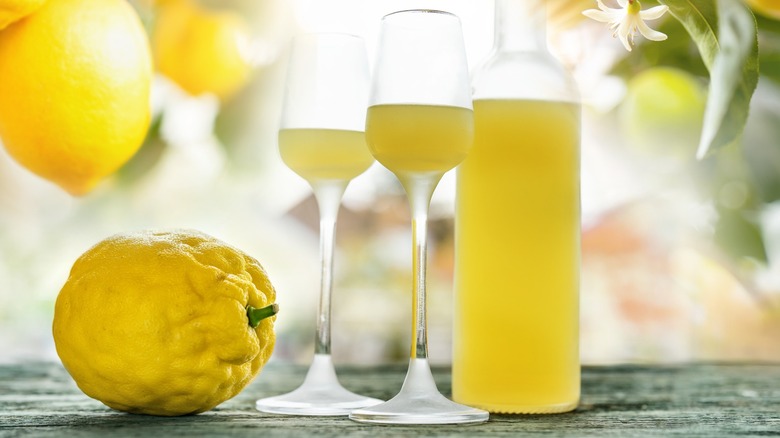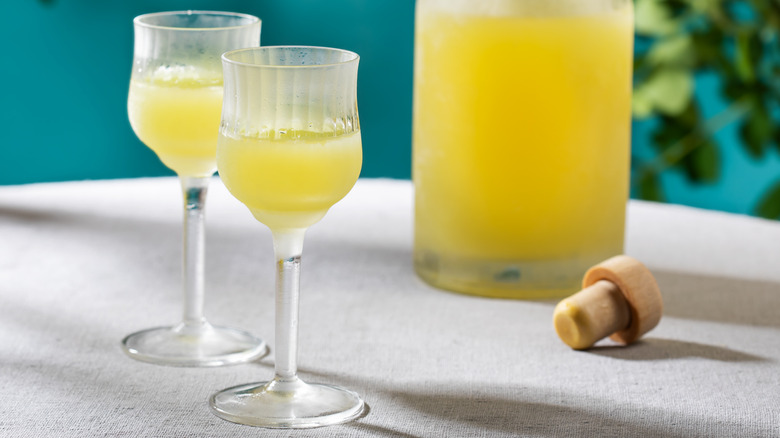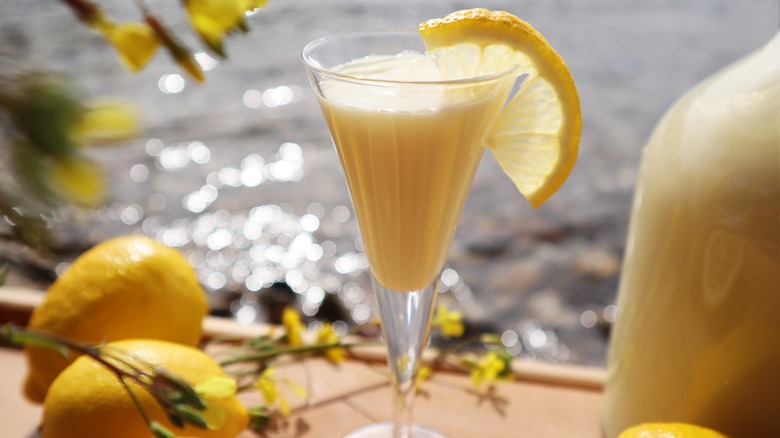How To Drink Limoncello Like A European
Summer-holiday mornings in southern Italy begin with sweet gelato or icy granita sandwiched between thick brioche buns. Lunch may be a feast of fresh seafood followed by a much-needed siesta, or riposo as they call it. And evenings are for a passeggiata (stroll around town) and leisurely dinners that stretch over several courses. And when all these meals are polished off, it's time for the quintessential nightcap: a small glass of limoncello.
Limoncello is an important digestif in the south of Italy — a syrupy lemon-based liqueur that helps digest those Neapolitan pizzas, rich seafood pastas, and fried cannoli that are famous in the region. As such, the drink is almost always drunk towards the end of a meal, either alongside dessert or after the mandatory post-dinner espresso has been gulped down. The drink is taken out of freezers — where it is usually stashed until it's time for an after-dinner tipple — and poured into chilled shot glasses or simple stemmed cordial ones. These can be either clear glasses that showcase the striking yellow hue of the liqueur, or more traditional small cups made out of ceramic.
Don't be fooled by the little shot-sized glasses though. The syrupy liquid may look deceptively easy to drink, but it packs quite the punch. Limoncello's alcohol content can be anywhere between 25% to 30%, which is why it is customary for the drink to be sipped on slowly rather than knocked back in one large gulp.
Limoncello is always served cold
For locals, the best way to savor limoncello is to drink it cold, and there are two reasons for this. Limoncello is known for its thick and smooth viscosity, and the low temperature helps keep it at this silky consistency. More importantly, however, it affects the liqueur's flavor.
Limoncello comes from the regions of southern Italy that are famous for producing magnificent, palm-sized lemons: The Amalfi Coast, Bay of Naples, and Sicily. As a result, limoncello is more than just a sweet digestif; it is a drink that showcases the fine produce grown in the region. Chilling it to temperatures between 35 to 45 degrees Fahrenheit tones down the liqueur's straightforward sweetness a notch, and highlights the crisp, tart, and wonderfully complex flavors of the glorious lemons that it is made from instead — and that is what limoncello is all about.
Rather than using ice to chill the liqueur, it's the drink itself that is kept cold. Though some store their limoncello in a refrigerator, most agree that it should be kept in the frigid depths of a freezer until there's a thin layer of frost on the bottle. Many limoncello bottles mimic this effect with frosted glass. Anything less and the liqueur is considered too warm for drinking. Even the glasses are chilled beforehand. This helps limoncello stay cold for longer, and it keeps the deliciously tart liquid from warming and turning too sweet before it can be finished.
Limoncello beyond an after-dinner digestif
Although limoncello is traditionally an after-dinner digestif, it can also be turned into sweet desserts and icy cocktails to sip on at other times of day (though remember that Italians rarely drink alcohol without food). It is often used to soak birthday cakes and adds depth to tangy lemon curds. It also brings a zesty contrast to creamy treats and fruit-based sorbets. A much-loved dessert on the Amalfi Coast is delizia al limone, or lemon delight. This sweet dish features little dome-shaped sponge cakes filled with and slathered in limoncello-spiked cream.
Limoncello is the perfect fruity base for spritz cocktails, too. Another popular and delightful tipple is bacio del limone (meaning lemon kiss), which is made by stirring the lemon liqueur into sparkling wine and then pouring the concoction over berries in a glass. There are also alternative versions of limoncello that are popular in Italy and parts of Europe. For instance, there is crema di limoncello — a lighter, creamier, and less tangy version of the lemon liqueur. It is made from milk instead of simple syrup and has a lower alcohol content.
You might also find limoncello under different names in other parts of Italy. For example, the north-western region of Liguria calls its lemon liqueur limoncino. It's practically the same as limoncello, except it's made from local lemons instead of those grown in southern Italy. And if you feel like making the liqueur at home, give our limoncello recipe a go.



